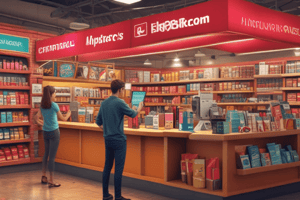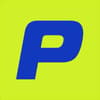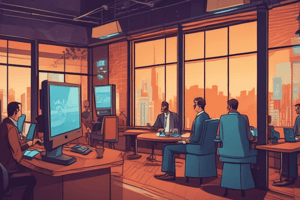Podcast
Questions and Answers
What is a key feature of private industrial networks?
What is a key feature of private industrial networks?
- They are independent third-party marketplaces for spot purchasing.
- They connect multiple buyers and sellers in a single digital marketplace.
- They allow large firms to link securely with suppliers and partners. (correct)
- They are primarily used for consumer-oriented transactions.
Which type of e-commerce involves eliminating intermediaries between producers and consumers?
Which type of e-commerce involves eliminating intermediaries between producers and consumers?
- Business to Business (B2B)
- Consumer to Consumer (C2C)
- Business to Consumer (B2C) (correct)
- Social E-commerce
What is a characteristic of net marketplaces (e-hubs)?
What is a characteristic of net marketplaces (e-hubs)?
- They focus exclusively on services rather than goods.
- They may offer both direct and indirect goods. (correct)
- They serve as direct connections between manufacturers and consumers.
- They are always operated by private companies only.
Which of the following best describes the drivers of e-commerce?
Which of the following best describes the drivers of e-commerce?
What is a defining aspect of Mobile E-commerce (M-commerce)?
What is a defining aspect of Mobile E-commerce (M-commerce)?
What is the primary objective of business process modeling (BPM)?
What is the primary objective of business process modeling (BPM)?
Which model is primarily concerned with the physical application architecture?
Which model is primarily concerned with the physical application architecture?
Which of the following is NOT typically a role involved in business process modeling?
Which of the following is NOT typically a role involved in business process modeling?
What does the logical model primarily focus on within application development?
What does the logical model primarily focus on within application development?
Which of the following elements is NOT part of the business model?
Which of the following elements is NOT part of the business model?
Which factor influences the development cost in a business model?
Which factor influences the development cost in a business model?
What is indicated by the expression 'Revenue > costs' in a business context?
What is indicated by the expression 'Revenue > costs' in a business context?
What aspect of the user model focuses on how a product feels to the end-user?
What aspect of the user model focuses on how a product feels to the end-user?
Which model focuses on the reuse of components?
Which model focuses on the reuse of components?
Which of the following is typically performed during the billing process?
Which of the following is typically performed during the billing process?
What is the main purpose of the RMA procedure in return orders?
What is the main purpose of the RMA procedure in return orders?
What is a common attribute of blanket orders?
What is a common attribute of blanket orders?
Which of the following best describes the matching principle in billing?
Which of the following best describes the matching principle in billing?
What does the process of picking and packing involve in the delivery and shipping phase?
What does the process of picking and packing involve in the delivery and shipping phase?
In the integration with Office during order processing, what is most likely a benefit?
In the integration with Office during order processing, what is most likely a benefit?
Which action is NOT typically part of the order-processing activities in ERP systems?
Which action is NOT typically part of the order-processing activities in ERP systems?
What usually drives the purchase initiative process?
What usually drives the purchase initiative process?
What is one of the key considerations when comparing proposals during the RFQ process?
What is one of the key considerations when comparing proposals during the RFQ process?
What occurs once a quotation becomes a purchase order?
What occurs once a quotation becomes a purchase order?
What primarily creates value in enterprise information systems (EIS)?
What primarily creates value in enterprise information systems (EIS)?
How does competitive advantage emerge in the context of technology according to the content?
How does competitive advantage emerge in the context of technology according to the content?
Which of the following accurately describes the role of enterprise information systems in organizations?
Which of the following accurately describes the role of enterprise information systems in organizations?
What is meant by 'commoditization of technology' in the context provided?
What is meant by 'commoditization of technology' in the context provided?
Which component is NOT part of the technology perspective of enterprise information systems?
Which component is NOT part of the technology perspective of enterprise information systems?
What aspect is highlighted as a significant barrier to copying innovations in business processes?
What aspect is highlighted as a significant barrier to copying innovations in business processes?
What role do 'mediating factors' play within technological business organizations?
What role do 'mediating factors' play within technological business organizations?
What is the primary function of a purchase order number in the procurement process?
What is the primary function of a purchase order number in the procurement process?
Which of the following does NOT form part of the 3-way matching process during vendor invoice check?
Which of the following does NOT form part of the 3-way matching process during vendor invoice check?
What is a key advantage of using an ERP system over a BOB system?
What is a key advantage of using an ERP system over a BOB system?
Which of the following is NOT a step involved in the materials resource planning (MRP) process?
Which of the following is NOT a step involved in the materials resource planning (MRP) process?
What is the purpose of an electronic invoice in the vendor invoice check process?
What is the purpose of an electronic invoice in the vendor invoice check process?
Which principle of MRP involves predicting future production requirements based on current demand?
Which principle of MRP involves predicting future production requirements based on current demand?
In the context of vendor payments, what does 'liquidity position' refer to?
In the context of vendor payments, what does 'liquidity position' refer to?
Which component of BOM would specify the quantity and type of components required for a product?
Which component of BOM would specify the quantity and type of components required for a product?
What is a possible drawback of using BOB systems compared to ERP systems?
What is a possible drawback of using BOB systems compared to ERP systems?
Which method is typically utilized to register obligations for vendor invoices?
Which method is typically utilized to register obligations for vendor invoices?
Flashcards
B2C (Business to Consumer)
B2C (Business to Consumer)
A type of e-commerce where businesses sell goods and services directly to consumers. This is the most familiar type of e-commerce. It allows consumers to compare prices, read reviews, and purchase goods and services easily.
B2B (Business to Business)
B2B (Business to Business)
A type of e-commerce where businesses sell goods and services to other businesses. This is often used for bulk purchases or supplies.
Private Industrial Network
Private Industrial Network
A network that connects businesses to suppliers and partners, using a secure website for communication and transactions. This helps businesses streamline operations and reduce costs.
C2C (Consumer to Consumer)
C2C (Consumer to Consumer)
Signup and view all the flashcards
E-business
E-business
Signup and view all the flashcards
Business Process Modelling (BPM)
Business Process Modelling (BPM)
Signup and view all the flashcards
Business Process
Business Process
Signup and view all the flashcards
Business Model
Business Model
Signup and view all the flashcards
Technology Model
Technology Model
Signup and view all the flashcards
Logical Model
Logical Model
Signup and view all the flashcards
User Model
User Model
Signup and view all the flashcards
Physical Model
Physical Model
Signup and view all the flashcards
Development Model
Development Model
Signup and view all the flashcards
Business Process Modelling Objectives
Business Process Modelling Objectives
Signup and view all the flashcards
Commoditization of Technology
Commoditization of Technology
Signup and view all the flashcards
Competitive Advantage from EIS
Competitive Advantage from EIS
Signup and view all the flashcards
Enterprise Information Systems (EIS)
Enterprise Information Systems (EIS)
Signup and view all the flashcards
Business Perspective of EIS
Business Perspective of EIS
Signup and view all the flashcards
Digitally Enabled Relationships
Digitally Enabled Relationships
Signup and view all the flashcards
Digital Networks in Business Processes
Digital Networks in Business Processes
Signup and view all the flashcards
Relationship Between Technology and Business Orgs
Relationship Between Technology and Business Orgs
Signup and view all the flashcards
Delivery and Shipping
Delivery and Shipping
Signup and view all the flashcards
Return Orders
Return Orders
Signup and view all the flashcards
Blanket Orders
Blanket Orders
Signup and view all the flashcards
Credit Memos
Credit Memos
Signup and view all the flashcards
Purchase Initiative
Purchase Initiative
Signup and view all the flashcards
RFQ and Vendor Selection
RFQ and Vendor Selection
Signup and view all the flashcards
Create Purchase Order
Create Purchase Order
Signup and view all the flashcards
Billing
Billing
Signup and view all the flashcards
Creditability and Availability Check
Creditability and Availability Check
Signup and view all the flashcards
Sales Order
Sales Order
Signup and view all the flashcards
Purchase Order Number
Purchase Order Number
Signup and view all the flashcards
Order Confirmation
Order Confirmation
Signup and view all the flashcards
Goods Receipt
Goods Receipt
Signup and view all the flashcards
Warehouse Workers
Warehouse Workers
Signup and view all the flashcards
Determine Goods Receipt
Determine Goods Receipt
Signup and view all the flashcards
Determine Storage Location
Determine Storage Location
Signup and view all the flashcards
3-way Matching
3-way Matching
Signup and view all the flashcards
Vendor Invoice Check
Vendor Invoice Check
Signup and view all the flashcards
Vendor Payment
Vendor Payment
Signup and view all the flashcards
ERP (Enterprise Resource Planning)
ERP (Enterprise Resource Planning)
Signup and view all the flashcards
Study Notes
Digital Economy
- Digital evolution has progressed significantly in recent years, influenced by factors like data growth, system advancements, and the pandemic.
- Key concepts driving digital economy evolution are storage, processing speeds, and bandwidth (processing and communication capabilities).
- Important technological drivers for digital economy are punched tape, magnetic tape, floppy disks, compact disks, hard drives, USB drives, and cloud storage.
Laws Associated with Digital Evolution
- Moore's Law: Processor speeds (and overall processing power) double approximately every two years. This leads to exponentially increasing data processing capabilities, and more rapid access to systems.
- Metcalfe's Law: The value of a network is proportional to the square of the number of users. Network value increases extremely rapidly as more users join the network.
- Gilder's Law: Bandwidth growth exceeds that of computer power. Bandwidth grows at least three times faster than computer power (doubles every six months compared to 18 months for computer power).
- Nielsen's Law: Speed and connectivity are linearly related – more speed but less connectivity is not necessarily the most valuable scenario.
Studying That Suits You
Use AI to generate personalized quizzes and flashcards to suit your learning preferences.
Related Documents
Description
Test your knowledge on key concepts related to e-commerce, business models, and business process modeling. This quiz covers various aspects, including mobile e-commerce, net marketplaces, and the roles involved in BPM. Perfect for students looking to deepen their understanding of modern business practices.





